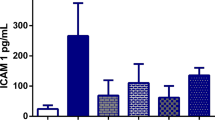Abstract
To investigate the effects of acute fecal peritonitis on plasma and tissue lipid peroxidation and possible protective effects of vitamin E (Vit E) and cimetidine at 4 h in a rat peritonitis model, four groups were designated as: controls, peritonitis, Vit E and cimetidine. Plasma, liver, lung and kidney thiobarbituric acid reactive substances (TBARS) and conjugated diene (CD) levels were measured to monitor oxidative injury. The present fecal peritonitis model caused a significant elevation in liver TBARS; however, neither Vit E nor cimetidine was effective in preventing TBARS formation. Administration of Vit E and cimetidine caused significant decrements from the peritonitis value in liver and lung CD levels.
Similar content being viewed by others
References
Halliwell B, Gutterdge JMC (1985) The importance of free radicals and metal ions in human diseases. Mol Aspects Med 8: 89–93
Niki E (1987) Antioxidants in relation to lipid peroxidation. Chem Phys Lipids 44: 227–253
Demling R, Lalonde C, Ikegami K, Pickard L, Nayak U (1995) Alpha-tocopherol attenuates lung edema and lipid peroxidation caused by acute Zymosan-induced peritonitis. Surgery 117: 226–231
Dwenger A, Funck M, Leuken B, et al. (1992) Effect of ascorbic acid on neutrophil functions and hypoxanthine/xanthine oxidase generated oxygen derived radicals. Eur J Clin Chem Clin Biochem 30: 187–191
Fang C, Peck M, Alexander J, et al. (1990) The effect of free radical scavengers on out-come after infection in burned mice. J Trauma 4: 453–456
French JF, Thomas CE, Downs TR, Ohlweiler DF, Carr A, Dage RC (1994) Protective effects of a cyclic nitrone antioxidant in animal models of endotoxic shock and chronic bacteremia. Circ Shock 43: 130–136
Kunimoto F, Morita T, Ogawa R (1986) The effect of experimental endotoxemia of oxygen free radical scavengers on experimental endotoxemia. In: Novelli GP, Ursini F (eds) Oxygen free radicals shock. International workshop 1985. Karger, Basel, pp 114–118
Maiorino M, Bodi L (1986) HPLC analysis of tissue thiobarbituric acid-reactive material during endotoxic shock in rats. In: Novelli GP, Ursini F (eds) Oxygen free radicals shock. International workshop 1985. Karger, Basel, pp 42–45
Seekamp A, Demling R (1988) Catalase prevents prostanoid release and lung lipid per-oxidation after endotoxemia in unanesthetized sheep. J Appl Physiol 65: 1210–1216
Burton GW, Foster DO, Perly B, et al. (1985) Biological antioxidants. Philos Trans R Soc Lond B311: 565–578
Burton GW, Ingold KU (1986) Vitamin E: application of the principles of physical organic chemistry to the exploration of its structure and function. Acc Chem Res 19: 1948.
Cheeseman KH, Collins M, Proudfoot K, et al. (1986) Studies on lipid peroxidation in normal and tumor tissues: the Navikoff rat liver tumor. Biochem J 235: 507–514
McCay PB (1985) Vitamin E: interactions with free radicals and ascorbate. Annu Rev Nutr 5: 323–340
Hazinski TA, France M, Kennedy KA, Hansen TN (1989) Cimetidine reduces hyperoxic lung injury in lambs. J Appl Physiol 67: 2586–2592
Rendic S, Kajfez F, Ruf HH (1982) Characterization of cimetidine, ranitidine and related structures’ interactions with cytochrome P450. Drug Metab Dispos 11: 137–142
Arthur MJP, Bentley IS, Tanner AR, et al. (1985) Oxygen-derived free radicals promote hepatic injury in the rat. Gastroenterology 89: 1114–1122
Demling R, Lalonde C (1989) Relationship between lung injury and lung lipid peroxidation caused by recurrent endotoxemia. Am Rev Respir Dis 139: 1118–1124
Demling R, Lalonde C, Youn Y, Daryani R, Campbell C, Knox J (1992) Lung oxidant changes after Zymosan peritonitis: relationship between physiological and biochemical changes. Am Rev Respir Dis 146: 1272–1278
Demling R, Ikegami K, Picard L, Lalonde C (1994) Administration of large doses of vitamin C does not decrease oxidant-induced lung lipid peroxidation caused by bacterial-independent acute peritonitis. Inflammation 18: 499–510
Demling R, Deryani R, Campbell C, Knox J, Youn YK, Lalonde C (1993) The effect of acute nonbacterial dependent peritonitis on lung and liver oxidant stress and anti-oxidant activity. Surgery 114: 517–578
Fantone J, Ward P (1982) Role of oxygen derived free radicals and metabolites in leukocyte dependent inflammation reactions. Am J Pathol 107: 395–418
Cleaver CLT, Hopkins AD, Kwong K, et al. (1974) The effect of postoperative peritoneal lavage on survival, peritoneal wound healing and adhesion formation following fecal peritonitis: an experimental study in the rat. Br J Surg 61: 601–604
Recknagel R, Glende E (1984) Spectrophotometric detection of lipid conjugated dienes. Methods Enzymol 105: 331–337
Till G, Hatherill JF, Tourteliotte WW, Lutz MJ, Ward PA (1985) Lipid peroxidation and acute lung injury after thermal trauma to skin: evidence of a role for hydroxyl radical. Am J Pathol 119: 376–384
Kamal AAM, Gomaa A, Khafif ME, et al. (1989) Plasma lipid peroxides among workers exposed to silica or asbestos dust. Environmen Res 49: 173–180
Ohkawa H, Ohihi N, Yagi K (1979) Assay for lipid peroxides in animal tissues by thio-barbituric acid reaction. Anal Biochem 95: 351–358
Ferluga J, Allison AC (1978) Role of mononuclear infiltrating cells in pathogenesis of hepatitis. Lancet II: 610–611
Tribble DL, Aw TY, Jones DP (1987) The pathophysiological significance of lipid per-oxidation in oxidative cell injury. Hepatology 7: 377–386
Author information
Authors and Affiliations
Rights and permissions
About this article
Cite this article
Tuncel, P., Gür, E.S., Kaya, E. et al. Effects of vitamin E and cimetidine on peritonitis-induced lipid peroxidation. Res. Exp. Med. 197, 235–241 (1997). https://doi.org/10.1007/s004330050072
Received:
Accepted:
Published:
Issue Date:
DOI: https://doi.org/10.1007/s004330050072




